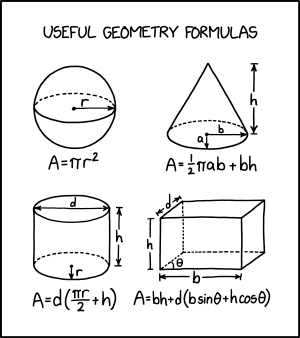August 30, 2021
#2509: Useful Geometry Formulas explain

[Four figures in two rows of two, each being a common two-dimensional representation of a three-dimensional object, with solid lines in front and dotted lines behind. Each figure has some labeled dimensions represented with arrows and a formula underneath indicating its area. Above the four figures is a header:]
Useful geometry formulas
[Top left; A circle with an inscribed concentric ellipse sharing its horizontal diameter. The edge of the ellipse above the major axis is drawn with a dotted line, while the lower edge is drawn with a solid line, similar to textbook depictions of a 3D sphere. The shared radius/semi-major axis to the right of the center is drawn as an arrow and labeled ‘r’. ]
A = πr²
[Top right; An ellipse with horizontal major axis, plus two straight lines: one from each end of the major axis, up to a point vertical to the center of the ellipse, so that the major axis of the ellipse (not drawn) and the two lines would form an isosceles triangle with a vertical axis of symmetry. The upper edge of the ellipse above the major axis is drawn with a dotted line, while the lower edge is drawn with a solid line, similar to textbook depictions of a right elliptical cone, or more commonly a right circular cone. The semi-minor axis of the ellipse is drawn with an arrow down from the center and labeled ‘a’ and the semi-major axis is similarly drawn to the right of the center and labeled ‘b’. To the right of the shape, the height of the isosceles triangle is drawn using arrows, and labeled ‘h’.]
A = 1/2 πab + bh
[Bottom left; Two ellipses of the same dimensions, with major axes horizontal, drawn vertically one above the other, with vertical lines connecting each end of the major axis of the top ellipse to the corresponding points on the bottom ellipse. The upper edge of the bottom ellipse above the major axis is drawn with a dotted line, while the lower edge is drawn with a solid line, similar to textbook depictions of a right elliptical prism or, more commonly, a right cylinder (circular prism). Inside the shape, the major axis of the upper ellipse is drawn as a double-ended arrow and labeled ’d’. The semi-minor axis of the lower ellipse is drawn as an arrow down from the center and labeled ‘r’. To the right of the shape, the length of the vertical lines is replicated using arrows and labeled ‘h’. ]
A = d(πr/2 + h)
[Bottom right; Two rectangles of the same vertical and horizontal dimensions, drawn with one offset diagonally to the upper right of the other, with diagonal lines connecting the corresponding vertices, forming a hexagon with opposite sides parallel. The upper right rectangle has its left and bottom sides drawn with dotted lines, and a similar dotted line is used connecting the bottom left corner of the two rectangles, similar to textbook depictions of rhomboid-based right prisms, or more commonly rectangular prisms. Outside the shape, the bottom edge of the lower rectangle is redrawn below the shape with arrows and labeled ‘b’. The length of the left edge is similarly redrawn to the left and labeled ‘h’. The length of the diagonal line connecting the upper left corners of the two rectangles is similarly redrawn on the top left using arrows and labeled ’d’. The acute angle between the bottom edge of the lower rectangle, and the dotted diagonal connecting the two lower left corners, is labeled ‘θ’]
A = bh + d(b sinθ + h cosθ)